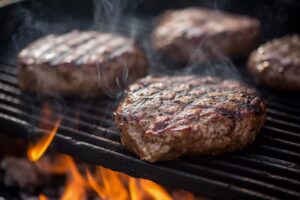| Vertical Smoker | Offset Smoker | |
|---|---|---|
| Design | Tall, narrow shape with multiple racks | Barrel-shaped with a separate firebox attached |
| Cooking Space | Limited cooking space, suitable for smaller cuts of meat | Large cooking space, suitable for bigger cuts or multiple items |
| Fuel | Charcoal, wood chips, or propane | Charcoal or wood |
| Heat Distribution | Provides consistent temperature and even heat distribution | Heat and smoke drawn from firebox into the main cooking chamber |
| Suitable for | Fish, poultry, and smaller cuts | Briskets, ribs, and larger cuts that require longer cooking times |
| Advantages | Compact size, efficient fuel consumption | Authentic barbecue flavor, large cooking space |
| Disadvantages | Limited cooking space, may require frequent refilling of water and fuel | Takes up more space, requires more skill and attention to heat management |
When it comes to choosing a smoker, there are two popular options that often come up for consideration: the vertical smoker and the offset smoker. Both of these types have their own unique features and benefits. In this article, we will explore the differences between vertical and offset smokers to help you determine which one is the best fit for your needs.
Vertical Smoker:
A vertical smoker, also known as a bullet or cabinet smoker, is designed to provide a consistent temperature and even heat distribution. These smokers have a tall, narrow shape with multiple racks for cooking. They are typically powered by charcoal, wood chips, or propane.
One advantage of vertical smokers is their compact size, making them suitable for smaller spaces such as balconies or patios. They are also known for their efficiency in fuel consumption, allowing you to smoke your food for extended periods without constantly refilling the fuel.
Vertical smokers are ideal for smoking fish, poultry, and smaller cuts of meat. The vertical design allows the smoke to circulate evenly around the food, resulting in a delicious smoky flavor. They are also great for those who prefer low and slow cooking, as the vertical configuration creates a more uniform heat distribution.
Offset Smoker:
Offset smokers, also called traditional or horizontal offset smokers, have a distinct barrel-shaped design with a separate firebox attached to one end. The heat and smoke generated in the firebox are drawn into the main cooking chamber, providing indirect heat for smoking. These smokers are usually fueled by charcoal or wood.
One major advantage of offset smokers is their large cooking space. The horizontal layout allows for more room to smoke larger cuts of meat or multiple items simultaneously. The offset design also creates a more customizable cooking experience, as you can play with the temperature and smoke distribution by adjusting the position of the firebox.
Offset smokers are known for creating an authentic barbecue experience. The longer cooking times and direct exposure to the smoke and heat result in tender, flavorful meat with a beautiful smoke ring. They are ideal for cooking briskets, ribs, and other large cuts that require longer cooking times.
Pros and Cons:
To summarize the key differences between vertical and offset smokers, here are some pros and cons for each:
Vertical Smoker:
Pros:
- Compact size, suitable for smaller spaces.
- Efficient fuel consumption.
- Even heat distribution for consistent results.
- Ideal for smoking fish, poultry, and smaller cuts.
- Great for low and slow cooking.
Cons:
- Limited cooking space for larger cuts or multiple items.
- May require frequent refilling of water and fuel.
Offset Smoker:
Pros:
- Large cooking space for bigger cuts or multiple items.
- Customizable cooking experience.
- Authentic barbecue flavor and smoke ring.
- Ideal for longer cooking times.
Cons:
- Takes up more space.
- Requires more skill and attention to heat management.
- May have more heat and smoke variances across the cooking chamber.
Conclusion:
In the end, the choice between a vertical smoker and an offset smoker comes down to your personal preferences and specific smoking needs. If you have limited space and prefer to smoke smaller cuts, a vertical smoker might be your best bet. On the other hand, if you have ample space and want to enjoy the authentic barbecue experience with larger cuts, an offset smoker may be the right choice for you.
Remember to consider factors like cooking space, cooking method preference, and the level of control you desire over heat and smoke distribution. Ultimately, the type of smoker you choose should be one that fits your needs and allows you to create mouthwatering smoked delicacies.
So, whether you decide to go vertical or opt for an offset smoker, make sure to enjoy the wonderful world of smoking and experiment with different recipes and wood flavors to create your own signature dishes.
